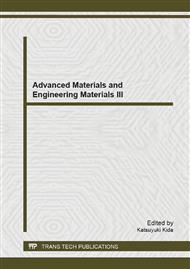p.291
p.295
p.299
p.303
p.314
p.320
p.325
p.329
p.337
The Effect of the Die Temperature on the Solidification Behaviour of the Al/SiCp Metal Matrix Composite: A Comparative Study of Experimental and Finite Element Analysis
Abstract:
This paper discusses the influence of die temperature on the solidification behaviour of A356/SiCp composites fabricated by squeeze casting method. Information on the solidification studies of squeeze cast composites is somewhat scarce. Experiments were carried out by varying the die temperatures for cylindrical shaped composite castings K-type thermocouples were interfaced to the die and the temperature-time history was recorded to construct the cooling curves. The cooling curves are also predicted from the finite element analysis (FEA) software ANSYS 13. The experimental and predicted cooling curves are not in good agreement. In addition to, the experimental and theoretical solidification times are studied. It was understood that the increase in the die temperature decreases the cooling rate.
Info:
Periodical:
Pages:
314-319
Citation:
Online since:
February 2014
Authors:
Price:
Сopyright:
© 2014 Trans Tech Publications Ltd. All Rights Reserved
Share:
Citation:


